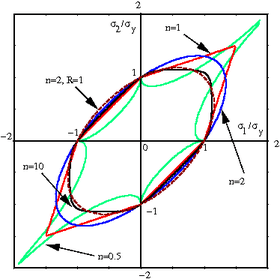Hosford yield criterion
The Hosford yield criterion is a function that is used to determine whether a material has undergone plastic yielding under the action of stress.
Hosford yield criterion for isotropic plasticity

The Hosford yield criterion for isotropic materials [1] is a generalization of the von Mises yield criterion. It has the form
where  , i=1,2,3 are the principal stresses,
, i=1,2,3 are the principal stresses,  is a material-dependent exponent and
is a material-dependent exponent and  is the yield stress in uniaxial tension/compression.
is the yield stress in uniaxial tension/compression.
Alternatively, the yield criterion may be written as
This expression has the form of an Lp norm which is defined as
When  , the we get the L∞ norm,
, the we get the L∞ norm,
 . Comparing this with the Hosford criterion
. Comparing this with the Hosford criterion
indicates that if n = ∞, we have
This is identical to the Tresca yield criterion.
Therefore, when n = 1 or n goes to infinity the Hosford criterion reduces to the Tresca yield criterion. When n = 2 the Hosford criterion reduces to the von Mises yield criterion.
Note that the exponent n does not need to be an integer.
Hosford yield criterion for plane stress
For the practically important situation of plane stress, the Hosford yield criterion takes the form
A plot of the yield locus in plane stress for various values of the exponent  is shown in the adjacent figure.
is shown in the adjacent figure.
Logan-Hosford yield criterion for anisotropic plasticity

The Logan-Hosford yield criterion for anisotropic plasticity [2][3] is similar to Hill's generalized yield criterion and has the form
where F,G,H are constants,  are the principal stresses, and the exponent n depends on the type of crystal (bcc, fcc, hcp, etc.) and has a value much greater than 2.[4] Accepted values of
are the principal stresses, and the exponent n depends on the type of crystal (bcc, fcc, hcp, etc.) and has a value much greater than 2.[4] Accepted values of  are 6 for bcc materials and 8 for fcc materials.
are 6 for bcc materials and 8 for fcc materials.
Though the form is similar to Hill's generalized yield criterion, the exponent n is independent of the R-value unlike the Hill's criterion.
Logan-Hosford criterion in plane stress
Under plane stress conditions, the Logan-Hosford criterion can be expressed as
where  is the R-value and
is the R-value and  is the yield stress in uniaxial tension/compression. For a derivation of this relation see Hill's yield criteria for plane stress. A plot of the yield locus for the anisotropic Hosford criterion is shown in the adjacent figure. For values of
is the yield stress in uniaxial tension/compression. For a derivation of this relation see Hill's yield criteria for plane stress. A plot of the yield locus for the anisotropic Hosford criterion is shown in the adjacent figure. For values of  that are less than 2, the yield locus exhibits corners and such values are not recommended.[4]
that are less than 2, the yield locus exhibits corners and such values are not recommended.[4]
References
- ↑ Hosford, W. F. (1972). A generalized isotropic yield criterion, Journal of Applied Mechanics, v. 39, n. 2, pp. 607-609.
- ↑ Hosford, W. F., (1979), On yield loci of anisotropic cubic metals, Proc. 7th North American Metalworking Conf., SME, Dearborn, MI.
- ↑ Logan, R. W. and Hosford, W. F., (1980), Upper-Bound Anisotropic Yield Locus Calculations Assuming< 111>-Pencil Glide, International Journal of Mechanical Sciences, v. 22, n. 7, pp. 419-430.
- 1 2 Hosford, W. F., (2005), Mechanical Behavior of Materials, p. 92, Cambridge University Press.






